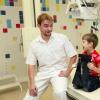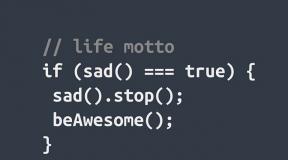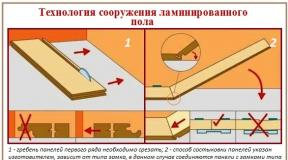Sensory aphasia is characterized by paraphasias. Clinical and psychological approach to the problem of sensory aphasia. What treatment is needed for speech disorder
- a disorder of previously formed speech activity, in which the ability to use one's own speech and / or understand the addressed speech is partially or completely lost. The manifestations of aphasia depend on the form of speech impairment; specific speech symptoms of aphasia are speech emboli, paraphasia, perseveration, contamination, logorrhea, alexia, agraphia, acalculia, etc. Patients with aphasia need an examination of the neurological status, mental processes and speech function. In case of aphasia, treatment of the underlying disease and special rehabilitation training are carried out.

General information
Aphasia - decay, loss of already existing speech, caused by local organic damage to the speech areas of the brain. In contrast to alalia, in which speech is not formed initially, with aphasia the possibility of verbal communication is lost after the speech function has already been formed (in children over 3 years old or in adults). Patients with aphasia have a systemic speech disorder, that is, expressive speech (sound pronunciation, vocabulary, grammar), impressive speech (perception and understanding), inner speech, written speech (reading and writing) suffer to some extent. In addition to speech function, the sensory, motor, personal sphere, and mental processes also suffer, therefore aphasia is one of the most complex disorders, which are studied by neurology, speech therapy and medical psychology.

Causes of aphasia
Aphasia is a consequence of organic damage to the cortex of the speech centers of the brain. The action of the factors leading to the onset of aphasia occurs during the period of speech already formed in the individual. The etiology of aphasic disorder affects its nature, course and prognosis.
Among the causes of aphasia, the largest specific weight is occupied by vascular diseases of the brain - hemorrhagic and ischemic strokes. Moreover, patients who have had a hemorrhagic stroke are more likely to have total or mixed aphasic syndrome; in patients with ischemic disorders of cerebral circulation - total, motor or sensory aphasia.
In addition, craniocerebral trauma, inflammatory brain diseases (encephalitis, leukoencephalitis, abscess), brain tumors, chronic progressive diseases of the central nervous system (focal variants of Alzheimer's disease and Pick's disease), and brain surgery can lead to aphasia.
Risk factors that increase the likelihood of aphasia include old age, family history, cerebral atherosclerosis, hypertension, rheumatic heart defects, transient ischemic attacks, head trauma.
The severity of aphasia syndrome depends on the location and extent of the lesion, the etiology of speech impairment, compensatory capabilities, the patient's age and premorbid background. So, with brain tumors, aphasic disorders increase gradually, and with TBI and stroke, they develop sharply. Intracerebral hemorrhage is accompanied by more severe speech impairments than thrombosis or atherosclerosis. The recovery of speech in young patients with traumatic aphasia is faster and more complete due to the greater compensatory potential, etc.
Classification of aphasia
Attempts to systematize the forms of aphasia on the basis of anatomical, linguistic, psychological criteria have been repeatedly undertaken by various researchers. However, the classification of aphasia according to A.R. Luria, taking into account the localization of the lesion in the dominant hemisphere - on the one hand, and the nature of the speech disorders arising in this case - on the other. In accordance with this classification, motor (efferent and afferent), acoustic-gnostic, acoustic-mnestic, amnestic-semantic and dynamic aphasia are distinguished.
Correction of aphasia
Corrective action for aphasia consists of medical and speech therapy directions. Treatment of the underlying disease that caused aphasia is carried out under the supervision of a neurologist or neurosurgeon; includes drug therapy, if necessary - surgery, active rehabilitation (exercise therapy, mechanotherapy, physiotherapy, massage).
The restoration of speech function is carried out in speech therapy classes for the correction of aphasia, the structure and content of which depends on the form of impairment and the stage of restorative learning. With all forms of aphasia, it is important to develop the patient's mindset for the restoration of speech, develop intact peripheral analyzers, work on all aspects of speech: expressive, impressive, reading, writing.
With efferent motor aphasia, the main task of speech therapy classes is to restore the dynamic scheme of word pronunciation; with afferent motor aphasia - differentiation of kinesthetic signs of phonemes. With acoustic-gnostic aphasia, it is necessary to work on the restoration of phonemic hearing and understanding of speech; with acoustic-mnestic - overcoming defects in auditory-speech and visual memory. The organization of training in amnestic-semantic aphasia is aimed at overcoming impressive agrammatism; with dynamic aphasia - to overcome defects in internal programming and speech planning, to stimulate speech activity.
Corrective work for aphasia should be started from the first days or weeks after a stroke or injury, as soon as the doctor permits. An early start of restorative learning helps prevent the fixation of pathological speech symptoms (speech embolus, paraphasias, agrammatism). Speech therapy work to restore speech in aphasia lasts 2-3 years.
Prediction and prevention of aphasia
Speech therapy work to overcome aphasia is very long and laborious, requiring the cooperation of a speech therapist, the attending physician, the patient and his relatives. Recovery of speech in aphasia proceeds the more successfully, the earlier the correction work is started. The prognosis of the restoration of speech function in aphasia is determined by the localization and size of the affected area, the degree of speech disorders, the timing of the start of restorative learning, the age and general health of the patient. The best dynamics is observed in young patients. At the same time, acoustic-gnostic aphasia, which occurs at the age of 5-7 years, can lead to a complete loss of speech or subsequent gross speech development (OHP). Spontaneous recovery from motor aphasia is sometimes accompanied by stuttering.
Prevention of aphasia is, first of all, in the prevention of cerebral vascular accidents and TBI, timely detection of tumor lesions of the brain.
Sensory aphasia is manifested by impaired understanding of words due to damage to the area of the cerebral cortex responsible for speech analysis. Therefore, sensory aphasia can manifest itself in two groups of symptoms - impaired understanding and impaired oral speech.
The area of the cortex that recognizes the meaning of words is located in the temporal region, in most people in the left hemisphere. It is also called the auditory analyzer or Wernicke's zone. Accordingly, sensory aphasia is also called Wernicke's aphasia.
Causes
In most cases, aphasia is caused by damaging effects on the brain. In adults, it can be:
- Strokes. The most common cause of aphasia. Both hemorrhagic and ischemic strokes in Wernicke's area are manifested by sensory aphasia.
- Temporal injuries
- Tumors of different origins
- Aneurysms of the vessels of the brain. In this case, aphasia can develop in two ways - due to the pressure of the aneurysm on the temporal region or during its rupture and subsequent bleeding.
- Infectious diseases - encephalitis
- Abscesses of the temporal region, can develop as a complication of otitis media
- Degenerative and demyelinating diseases.
Aphasia in children is more likely to result from trauma, tumors, aneurysms, and infections. Strokes are extremely rare in them, but stroke cannot be completely ruled out as a cause of aphasia. Also, in children, cases of epilepsy in combination with acquired aphasia are described, named after the scientists who first described the disease.

Aphasia manifests itself in two large groups of symptoms - the first combines a violation of speech perception, the second - a violation of the pronunciation of words.
Impaired speech perception in sensory aphasia is associated with the inability to recognize words and sounds. They are perceived as an incoherent mixture of sounds, speech seems foreign. Patients do not understand the meaning of words. At the initial stages of the disease, the ability to determine the group belonging of the named object is sometimes retained - to small or large, living or inanimate, etc.
A distinctive feature of sensory aphasia is the intact response to instructions associated with an action. For example, the patient correctly understands the commands "raise his hand" or "nod", but will not be able to answer the name of any object.
In the future, in the absence of treatment, the violation of perception is aggravated up to a complete lack of understanding of speech.
Speaking disorder appears due to the impossibility of auditory control over the sounds spoken. The patient speaks in separate, unrelated words, sounds, can swap sounds in a word, pronounce only a part of them. The transmission of intonations in speech is impaired. Gradually, the pronunciation of words is restored, the patient becomes verbose, tries to explain his thoughts, selects synonyms for words that he cannot remember.
The absence of criticality in patients is characteristic. They are confident that they speak correctly and clearly and get annoyed when they are not understood.
Accordingly, the violation of oral speech is violated and written. Reading suffers minimally - the patient confuses the position of stress in words, he reads some letters incorrectly, which interferes with the understanding of what he read. However, in general, the ability to understand the meaning of the written text is preserved quite fully.
Associated symptoms

Sensory aphasia is rarely the only symptom of a causative disorder. It is often accompanied by signs of paranoia and agitation. Aphasia after a stroke can be combined with impaired mobility in the right half of the face, smoothing the right nasolabial fold. Loss of parts of the visual field on the right is characteristic. Significant neurological impairment is usually absent.
With aphasia due to an abscess or encephalitis, there are general signs of an infectious process - fever, signs of intoxication, in the case of encephalitis, characteristic changes in the cerebrospinal fluid.
Features of sensory aphasia in children
Aphasia in children can be confused with alalia (primary lack of speech). The main difference between these syndromes: with aphasia, a regression of developed speech occurs, with alalia, speech does not develop initially. Due to the insufficient formation of the speech apparatus, aphasia in children has some characteristic features:
- Aphasia in children occurs very quickly and speech functions are restored just as quickly. Lack of noticeable improvement over several weeks significantly worsens the prognosis for recovery.
- The manifestations of aphasia, especially in young children, are extremely scarce. Their speech is not yet sufficiently developed for a full-fledged deployment of the clinic. Most often, in children, only motor aphasia or sensory aphasia can be differentiated.
- To restore speech in a child, the functions of the speech center must be restored or compensated for by neighboring areas of the cortex. In adults, compensation is often possible thanks to a developed system of logical connections in speech, a developed conceptual apparatus.
Forms of sensory aphasia
The addition of additional lesions in the cortex leads to the appearance of additional speech disorders. This is how the forms of aphasia are distinguished:
- Semantic aphasia is a violation of understanding the relationship of words, objects, especially spatial;
- -phasia - violation of the account;
- Sensory-motor aphasia - impaired understanding of speech in combination with the impossibility of correct articulation;
- Total aphasia is a degradation of all types of speaking and writing, along with a disorder of speech understanding.
Diagnosis of sensory aphasia
It consists in finding the causative disease. This requires a set of measures:
- Thorough questioning of the patient to identify risk factors preceding the disease;
- Neurological examination to look for associated disorders that may not be visible externally;
- A set of instrumental examinations - electroencephalogram, CT or MRI, contrast angiography of the head vessels will help to reveal the volumetric formation of the cranial cavity, vascular aneurysms, the presence of hemorrhages or the consequences of ischemic stroke, abscesses and other pathologies.
Sensory aphasia treatment
Quite a long and multicomponent process, a significant part of which depends on the cause of aphasia. Treatment necessarily includes classes with a speech therapist. It is advisable to divide the methods of treatment of aphasia into medication and speech therapy.
Speech therapy correction of sensory aphasia

Classes with a speech therapist will help restore the correct pronunciation of sounds, expand vocabulary, and return meaningful speech. For this, special exercises and equipment are used, with which only a professional speech therapist can work. At home, you can also do a number of simple exercises: ask the patient to name the surrounding objects, body parts, and combine the written word with his image. Communicate more with the patient - at first, mainly ask simple questions that can be answered "yes" or "no", then - go to open-ended questions, practice thematic dialogues.
It is important to create a comfortable environment for the patient. The patient with aphasia actually turned out to be transferred to a foreign country with an unfamiliar language. Talk to him calmly and slowly, let's feel your support.
Medication for sensory aphasia
Universal drugs prescribed for aphasia of any origin are nootropics, B vitamins and neurotrophics.
The choice of other drugs for treatment depends on the cause of the aphasia. So, with a stroke, it is possible to prescribe thrombolytics or hemostatic drugs, depending on its form. For the treatment of infectious brain damage, antibiotics and anti-inflammatory drugs are used.
Sensory correction video tutorial
This disease is a speech disorder in which the patient loses the ability to use words during communication to express his thoughts, despite the fact that he has completely preserved hearing and articulation apparatus. It is known that speech is considered a functional system, an integrative-neural organization of the human brain, at the same time, special "speech zones" are designated in it, located in the cerebral cortex, which are responsible for aphasias of various types. Sensory aphasia is an acquired disorder that occurs when the speech centers of the brain are affected.
With sensory aphasia, it should be borne in mind that not only the absolute absence of speech, but also its altered structure is typical for this disease. The patient has a very poor vocabulary, and also cannot form the simplest sentences. Very often, patients with sensory aphasia are fully aware of what this or that thing or object is, but they find it difficult to remember what it is called and cannot pronounce the name. To better understand what such disorders are, you need to have an idea of the classification of different types of disorder, and pay attention to individual forms. In order to better understand the principle of violations, it is necessary to get acquainted with the classification of this type of disorder, to study in more detail each form of the disease.
Sensory aphasia is also called Wernicke's aphasia. It is characterized by the patient's loss of the ability to perceive spoken language. If other people are talking next to him, he remains indifferent, and does not react in any way, since he does not understand the meaning. In addition, a written text also means nothing to such a patient. The peculiarity of sensory aphasia is that a person can have excellent hearing, and he hears normally when spoken to. But, since the cortical part of the auditory analyzer is affected, the interpretation of the heard conversation is impossible for the patient. Any word, regardless of tone and volume, is perceived by the patient as an incoherent sound. It also happens that the patient perceives his native language as a foreign one that is unfamiliar to him. Due to this factor, sensory aphasia is also called acoustic-gnostic aphasia.
 Experts have established many causes of this type of aphasia. First of all, sensory aphasia is due to the fact that the tumor process has struck the sections of the neocortex, strokes, various inflammatory diseases, traumatic injuries, encephalitis, leukoencephalitis, are also considered the cause. In addition, doctors have shown that certain types of mental disorders also trigger aphasia.
Experts have established many causes of this type of aphasia. First of all, sensory aphasia is due to the fact that the tumor process has struck the sections of the neocortex, strokes, various inflammatory diseases, traumatic injuries, encephalitis, leukoencephalitis, are also considered the cause. In addition, doctors have shown that certain types of mental disorders also trigger aphasia.
A person with sensory aphasia can only speak in scraps of words that have no connection with each other. Quite often, this state is accompanied by a general increased emotionality and pronounced motor activity. In most cases, the patient is capable of performing simple commands. For example, he can sit down on instructions, close his eyes, wave his hand. If the doctor asks to repeat individual words and phrases after him, the patient pronounces them exactly, but at the same time he does not realize what they mean and does not see any meaning in them. In sensory aphasia, the patient's speech is saturated with verbal paraphasias, neologisms and echolalia prevail in it. At the same time, patients are very volatile, which is called logorrhea, jargon-aphasia.
It is almost impossible to understand such patients, and very often they look mentally ill in the eyes of others. Reading and writing in patients is grossly impaired, and the patient cannot write under dictation at all. Sometimes the function of cheating, that is, copying, remains. Sensory aphasia may be accompanied by symptoms such as impaired right-left orientation, acalculia, and upper quadrant hemianopsia. Sometimes sensory aphasia manifests itself in a milder form, and then the patient has difficulty understanding metaphors, complex phrases. For example, it is difficult for him to comprehend what “golden hands” or “disservice” are. Clinical practice rarely encounters examples such as "pure" aphasias. In an isolated form, sensory and motor aphasia almost never occur, mainly complex diseases are observed.
 Despite the fact that modern medicine considers aphasias to be curable, the recovery process itself is extremely laborious and time-consuming, therefore, starting treatment, the patient must prepare for a serious struggle for his health. To achieve the desired goal, it is necessary that consolidated efforts be made not only by a speech therapist-aphasiologist, but also by the patient himself. Also, the treatment requires the attention of his loved ones, who must provide comprehensive support.
Despite the fact that modern medicine considers aphasias to be curable, the recovery process itself is extremely laborious and time-consuming, therefore, starting treatment, the patient must prepare for a serious struggle for his health. To achieve the desired goal, it is necessary that consolidated efforts be made not only by a speech therapist-aphasiologist, but also by the patient himself. Also, the treatment requires the attention of his loved ones, who must provide comprehensive support.
A particular difficulty in treatment is that the exchange of information between the patient and the doctor, as well as normal communication, is rather difficult. The patient cannot talk about his feelings, does not understand the doctor's questions, and is not even able to express his opinion in writing.
Wernicke's sensory aphasia is a neuropsychological and neurological disorder characterized by impaired understanding of speech. According to A. Luria, a patient with sensory aphasia is unable to distinguish the phonemic composition of words. The concept of "phonemes" is lost, therefore, the phenomenon of alienation of the meaning of a word fits into the basis of pathology.
Sensory dysphasia has a central mechanism, which is based on the pathology of the higher cortical function of the temporal cortex. In this case, the peripheral hearing organs, pathways and nerve fibers are intact. This means that a person hears speech, phrases and words addressed to him, but he does not understand the meaning: for the patient, this is a set of meaningless sounds. For him, his native language becomes foreign.
Causes
The lesion focus in sensory aphasia is localized in the Wernicke zone. This is the area of the temporal cortex, which is located in the superior temporal gyrus, in front of the frontal. Wernicke's speech area is responsible for understanding and mastering auditory and writing.
Most often, sensory aphasia occurs after ischemic stroke. The following factors are prevalent: hemorrhagic stroke, intracranial neoplasms, damage to brain tissue due to encephalitis or abscess, traumatic brain injury. Less commonly, Wernicke's dysphasia develops after demyelinating diseases like multiple sclerosis, if the localization of sensory aphasia coincides with the focus of demyelination. After these reasons, there is a "chronic" impairment of speech understanding.
However, dysphasia can be transient, temporary, which goes away on its own. Transient dysphasia occurs due to epilepsy, transient ischemic attack, and migraine. It should be remembered that the presence of dysphasia during a transient ischemic attack indicates an increased risk of developing acute cerebral circulation within the next two weeks.
Wernicke's sensory dysphasia may result from neurodegenerative diseases. Most often, speech pathology correlates with frontotemporal dementia and Alzheimer's disease. At the same time, in the clinical picture of a neurodegenerative disease, nothing but dysphasia is almost observed.
Symptoms
The clinical picture of speech disorder consists of separate groups of speech pathologies. Signs of sensory aphasia:
- Impaired understanding of speech. It is characterized by a loss of the skill of recognizing words, namely phonological and semantic structures. Patients distinguish individual sounds well and understand their structure, the problem arises at the level of combining sounds into a word.
- Impaired understanding of colloquial speech. The degree of speech understanding in sensory aphasia is reduced to a minimum. The problem arises at the level of phonemic, syntactic and semantic structures. Even contact with a doctor is often difficult. Patients carry out commands and requests for diagnosis only after the doctor touches them. It complicates contact and a violation of understanding the meaning of elementary gestures.
- The phenomenon of alienation of the meaning of a word. The violation is observed at the semantics level. The term was introduced by A. Luria. The bottom line is that the patient pronounces the word correctly, repeats after the researcher, but does not have subject correlation. This means that, repeating the word "table" or "chair" several times, the patient cannot point his finger at the table and chair, because he does not understand what these terms mean.
- Pathology of the phonological level. Usually seen in patients with moderate dysphasia. The syndrome is easy to understand by looking at the following clinical example. The doctor tells the patient: when I say "A" you raise your hand, when I say "O" you do not raise your hand. After sounding the letters, the patient correctly follows the commands. However, difficulties arise when several vowels are combined, for example, if the command “raise your hand” is assigned to the combination “AO U”, the patient will not fulfill it.
Violation of understanding at the phonological level is demonstrated when trying to rewrite a word. So, the patient only copies the letters, not correlating them together and not understanding the meaning of what was written. - Pathology of perception of words at the level of hearing. Verbal deafness is expressed in a misunderstanding of the addressed phrase.
- Auditory agnosia. This is expressed in the fact that the patient correctly and adequately perceives non-verbal sounds. The patient recognizes the noise of the wind, the hum of engines, notes from the piano and the singing of birds and can correctly identify the sound and the source.
- Violation of expressive speech. It is most pronounced in the first week after a stroke. It is characterized by a continuous stream of few intelligible sounds and phrases. Short syllables prevail. Sentences and phrases are mostly fluid. This is the main difference from, in which speech is fragmentary and with long pauses.
- Pathology of dialogue. Patients find it difficult to find the right words in a conversation. The speech production increases, that is, the patients speak a lot, but not intelligibly. With severe dysphasia, speech is completely unclear to others, since it represents a stream of different sounds that do not add up to words or phrases.
- Violation of the nominative function. This is expressed in the fact that the patient cannot name the name of an object, phenomenon or action.
- Pathology of articulation, facial expressions and gestures. Symptoms of the disorder are rare. Usually they are expressed in a violation of the selection of intonation and the wrong duration of vowels.
- Agrafia and alexia. Reading and writing under dictation is partially impaired.
Sensory dysphasia is often associated with other neurological disorders, especially after stroke. Dysphasia is combined with a right-sided decrease in muscle strength (hemiparesis), weakness in the right hand, right-sided visual impairment, or a decrease in hemitype sensitivity.

Diagnostics
Diagnostics is carried out by a psychiatrist together with a speech therapist. After the patient regains consciousness, diagnostic work begins with him. First, doctors talk to the patient. During the conversation, specialists listen to the speech and examine the understanding of the words addressed to the patient.
Attention is drawn to speech production, the number of words spoken per minute, the presence of repetitions of words and phrases, the duration of phrases and their structure. Taking into account the violation of cases, the presence of conjunctions, prepositions. When assessing the structure of the narrative, doctors look at motor function in parallel:
Correction methods
Treatment of sensory aphasia begins with the restoration of the general condition of the patient. Doctors must make sure that the patient can already learn without harm to his health and without a strong psychophysiological stress.
First, drug therapy is prescribed, which stabilizes the patient's condition and improves brain trophism. Etiotropic therapy is carried out, eliminating the cause of dysphasia.
The main task of restorative education is to rehabilitate speech skills and perception of dialogue, return the patient to society, and teach them to independently monitor the state of their speech.
Speech recovery in sensory aphasia is performed by a speech therapist. It is believed that young people have the greatest chance of complete recovery, having a higher education and hemorrhagic stroke (in terms of the prognosis ratio, ischemic stroke is more severe than hemorrhagic stroke).
Speech therapy exercises are performed independently under the supervision of relatives or "in person", directly with a specialist. The exercises should be performed immediately after the stroke, as soon as the patient regains consciousness. Classes with a speech therapist last the entire rehabilitation period.
In rehabilitation, the frequency and intensity of training matters. So, studies have shown that speech recovery does not depend so much on the complexity and specifics of tasks as on the pressure and frequency of the exercises themselves.
Loss of speech in full or in part for a person is a difficult situation that significantly disrupts the quality of life and leads to disability.
In medicine, this problem is called aphasia. It occurs when the inhibition of functional activity due to damage to certain areas of the cerebral cortex and is a symptom of serious or trauma.
Depending on the localization of the pathological focus, speech disorders can have different manifestations; this is associated with the allocation of several main types of aphasias.
One of the most severe forms is sensorimotor aphasia, which is a combination of two types of speech disorders (s). What is the peculiarity of this clinical symptom and how to cope with it?
Factors provocateurs of violation
The development of aphasia is always associated with a pathological process or damage to the areas of the brain responsible for speech. This function in each hemisphere has a motor (motor) and sensory (sensory) support.
For example, afferent and efferent aphasia (a violation of the ability to pronounce words) appears when the area of the cortex that is responsible for movement is affected (the inferior frontal gyrus of the left hemisphere).
(lack of understanding of the meaning of one's own and other people's words) is associated with pathology in the cortical section of the auditory analyzer (the upper part of the temporal lobe of each hemisphere). The combined lesion of these areas leads to the development of total (sensorimotor) aphasia.
The main reasons for the appearance of this symptom:

The contributing factors are:
- venerable age;
- poor family history;
- concomitant serious diseases - atherosclerosis, decompensated diabetes mellitus, arterial hypertension, coronary artery disease, frequent, heart and vascular defects.
Clinical manifestations
Sensomotor aphasia is a combination of symptoms common to both types of speech disorders. Such a difficult clinical situation causes significant communication difficulties for people with preserved intelligence and leads to disability.
It manifests itself in two forms:
- afferent form- the patient is not able to pronounce individual sounds at will or at the request of someone due to problems with articulation, however, spontaneous pronunciation of such sounds at other times is possible;
- efferent form- a person can speak individual sounds or syllables, but cannot put them into words, he does not have the ability to switch from one sound to another, therefore such a patient often repeats the same syllable or gets stuck immediately at the first pronunciation and stops speaking further altogether.
 Sensory (acoustic-gnostic aphasia) is characterized by a complete or partial lack of understanding of one's own or someone else's speech with normal hearing.
Sensory (acoustic-gnostic aphasia) is characterized by a complete or partial lack of understanding of one's own or someone else's speech with normal hearing.
Such patients can correctly pronounce words and build phrases, they often speak quickly and often without understanding the meaning of what they heard. Both spontaneously appearing speech and repetition after a speech therapist, description of objects and pictures, or reading aloud suffer.
The combination of sensory and motor aphasia symptoms results in a clinical manifestation of sensorimotor disorder as the most severe of all. At the same time, the patient does not understand others and cannot speak normally himself.
The degree of loss of your speech and the ability to correctly recognize the conversation of people around you will depend on the individual characteristics and the severity of the damage.
This complex type of aphasia is also called total due to the violation of all aspects of human speech functions. Often, it can be combined with other neurological manifestations (for example, with) or general symptoms (distraction, apathy, drowsiness).
Medical assistance
For patients with aphasia, it is necessary to organize two directions of treatment.

The prognosis depends on the individual characteristics of each patient - his age, health status, the presence of concomitant diseases and family predisposition, as well as on the location and size of the lesion in the cerebral cortex.
In any case, recovery will be more successful with an early start of recovery work and the implementation of all the doctor's recommendations in full, as well as with the active participation and help of relatives and friends of the patient with aphasia.


















